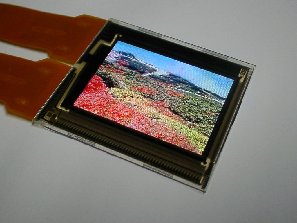
The Advantages of LEPs

LEPs have one major potential application - as a display technology. There are other minor applications, for example, Philips are already using PLEDs as LCD display backlights. However as a display technology LEPs are fabulously exciting.
Applied LEPs could replace all current display technologies. Examine the following feature-benefit table from ctdltd.co.uk:
| Feature | Benefit |
|---|---|
| Processability | -Flexible substrates possible. -Large area coating. -Simple construction. -Single substrate processing. |
| Light Emitting/Optical | -No backlight needed. -No colour filter needed. -No polarizers. -High contrast. -No aperture loss. -180 degree viewing angle. |
| Patternable | -Complex light emission patterns can be simply defined. -Very high resolution potential. -Any pixel shape and size possible. |
| Low Voltage and DC drive | -Can be battery driven. -Less than 5V activation. -Low voltage is preferable. |
| Formable Substrates | -Displays can be shaped to product - allows for innovative design. -Easy to integrate to manufacturing process. -Can be continuously coated. |
| Fast Switching Speed | -Can be used for video display. -Is unaffected by temperature. |
| Lightweight | -Portability. -Ultra-thin materials. -Potential System-on-Glass structures. |
| Solid State devices | -Ruggedness. |
| Thin Films | -Allows use of polarisers to give high contrast. -Ultra-thin construction. -Potential plastic substrates. |
CRT displays are big, heavy, expensive, high wattage, high voltage and have limitations placed on their maximum size.
LCD displays are expensive, limited in resolution and have slow refresh rates which is inappropriate for video display. Otherwise they are a better alternative to CRT displays in some applications.
Other alternatives exist such as projection screens and plasma screens. But all could be replaced by LEP technology due to the wonderful number of advantages they entail, and possibly most importantly, the technology is simple and thus comparatively, very cheap to manufacture.

However, the technology is not yet mature enough to market full colour LEP displays. Above is shown a prototype created by DuPont in 2001. Pixel displays like these are created by tracing a matrix of LEP or by interlacing the diode electrodes. The image on the right shows a high resolution display; further development should lead to higher resolutions still.
Novel Applications
There are many instances where cheap displays would be of huge benefit. For example, supermarkets often struggle to ensure items on their shelves are correctly labelled, and more applicably, correctly priced. Cheap LEP shelf labelling could be remotely changed from a central computer so that prices are always correct. Special offers could flash and grab the customer's attention, perhaps scrolling descriptions, or details of warehouse stock levels, etc. etc.
With a more active imagination there are many more possibilities. Dynamic wallpaper for instance. Your walls could change depending on the season, or perhaps they could morph gradually from one pattern to the next, or be used as a giant television screen. Also, because LEPs can be coated, entire products could be cased in display. Most product designers would probably require some time to fully realise what could be done with this new display technology.
Summary
LEP technology has a great deal of potential, even the window blind TV from Back to the Future part II could now be possible! If you want to learn how dot matrix displays are made, head to the Future of LEPs section, although you may want to learn how LEPs work first..